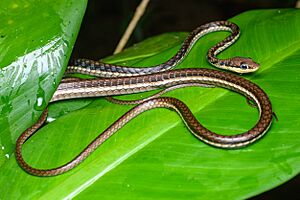Dendrelaphis haasi facts for kids
Quick facts for kids Dendrelaphis haasi |
|
|---|---|
 |
|
| Conservation status | |
| Scientific classification | |
| Genus: |
Dendrelaphis
|
| Species: |
haasi
|
Dendrelaphis haasi, often called Haas's bronzeback, is a slender snake that lives in trees. It belongs to the Colubridae family, which is a very large group of snakes. You can find this snake in the warm, green forests of Southeast Asia.
Contents
What's in a Name?
The scientific name, haasi, was chosen to honor a Dutch scientist named species:C. P. J. de Haas. He was a herpetologist, which means he studied reptiles and amphibians.
Snake Family Tree
Haas's bronzeback snake is part of a group called Dendrelaphis. This group includes 48 other types of snakes. These snakes are often called "vine snakes" because they are long and thin, like vines. They are closely related to another group of snakes called Chrysopelea, which are known as flying snakes!
Where It Lives
You can find D. haasi in several countries in Southeast Asia. These include Brunei, Indonesia, Malaysia, and Singapore.
Its Home
This snake loves to live in forests, especially those close to the sea. But sometimes, you might even spot one in a garden! They like places with lots of trees and plants where they can climb and hide.
What It Looks Like
D. haasi is a very thin snake with a super long tail. Its tail can be more than a third of its total body length! For example, one snake measured about 57.5 centimeters (about 22.6 inches) from its snout to its bottom, and its tail was about 33 centimeters (about 13 inches) long.
Daily Life
This snake is diurnal, which means it is active during the day. It is also fully arboreal. This means it spends almost all its time living in trees and rarely comes down to the ground.
What It Eats
D. haasi is a predator. It hunts and eats frogs and lizards. Its quick movements and ability to climb help it catch its prey in the trees.
How It Reproduces
Like many snakes, D. haasi is oviparous. This means the female snake lays eggs. The baby snakes then hatch from these eggs.


